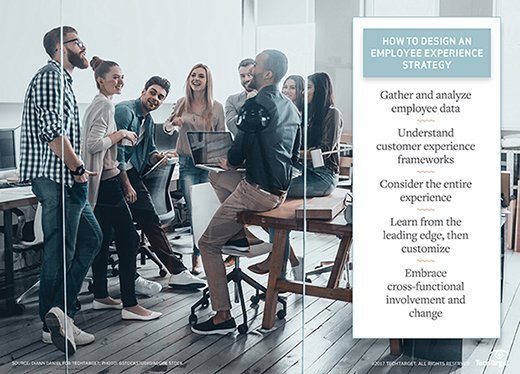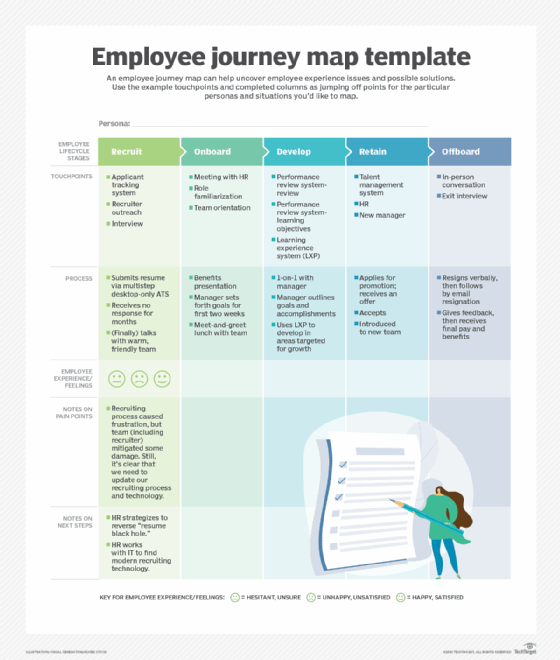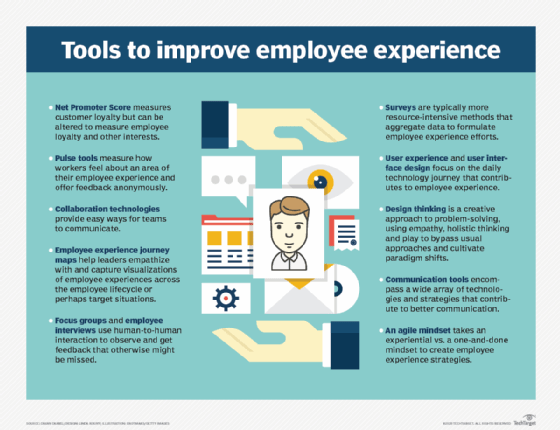
employee experience
What is employee experience?
Employee experience is a worker's perception of the organization they work for during their tenure. It includes an employee's entire journey through all the touchpoints of the employee lifecycle, from job candidacy to the exit from the company. The company's physical workspace, culture and technology are all important components of the employee experience. The term employee experience is sometimes abbreviated as EX.
Creating a positive employee experience is generally seen as a competitive advantage for companies. A good experience is often linked to higher productivity and better business outcomes, such as return on investment.
Benefits of a positive employee experience
Strengthening the employee experience has numerous benefits that are all associated with employee job satisfaction leading to higher profits and a better ranking in an industry or market. Some advantages include the following:
- More engaged, productive employees. Disengaged employees can cost companies billions of dollars each year through lower productivity and profitability and increased absences. Engaged employees are more productive and bring other advantages, such as improved employee retention rates and workplace safety.
- Higher quality of work. Satisfaction levels influence job success more than IQ or skill set, according to research from Harvard University psychologist and happiness expert Shawn Achor and others. For example, a "happy" brain sees more possibilities and is more creative.
- Improved customer relations. The employee experience affects all areas of the business, including the customer experience (CX). Indeed, many industry experts believe CX is a direct result of employee experience. Happy employees are more likely to convey better moods and emotions while interacting with customers. They also tend to be more engaged with, dedicated to and articulate about an organization's products, services or mission, which enables them to give better support to customers and prioritize customer satisfaction.
Challenges of employee experience
While employee experience is often linked to benefits, there are several challenges to implementing a positive employee experience. Organizations must overcome various obstacles to ensure that employees feel valued, motivated and engaged. These challenges include the following:
- Lack of recognition. Employees might feel unappreciated if their hard work and contributions go unnoticed. Without proper recognition, they become disengaged and less motivated to do their best.
- Inconsistent employee engagement. Ensuring consistent employee engagement across teams and departments can be challenging. Different managers may have varying levels of awareness and commitment to fostering a positive employee experience, leading to inconsistencies in engagement levels. It's important to make employee engagement a part of the corporate culture.
- Resource requirements. Organizations with limited resources may struggle to implement comprehensive employee recognition programs or invest in initiatives that enhance the overall employee experience. This can hinder their ability to create a positive work environment. Limited resources also reduce the ability to collect employee sentiment analysis.
- Communication and feedback gaps. Effective communication and regular feedback are vital for a positive employee experience. However, organizations may face challenges in providing timely and constructive feedback, leading to misunderstandings and decreased employee engagement.
Why is employee experience important?
The benefits of good employee experience encompass why employee satisfaction should be a priority. Here's a more detailed look at why this is the case.
The most successful organizations attract and retain top talent. When the economy is good, the competition for top talent is highly competitive and the need for effective talent acquisition and retention grows. During difficult times, such as the COVID-19 pandemic and recession, attention to employee experience can help companies become more competitive and prevent the worst repercussions.
In general, companies that have positive employee experience, as indicated by barometers such as high scores in research studies and inclusion in top places to work lists, also have high customer experience scores and positive revenue growth. Numerous studies show a direct link between employee experience and customer experience.
Employee perceptions and experiences will affect every other aspect of a company's processes. Happy employees who perceive their experience as good are more engaged and complete tasks more effectively and efficiently. Employee experience directly affects other aspects of the workplace. For example, employees who have positive experiences are more likely to commit to and stay at an organization than employees who have negative experiences.
Happy employees are more likely to promote the company as a great place to work. This leads to more candidate referrals for open positions and increased fill rates because job seekers pay attention to employee work experience and company culture ratings. This is one reason why company review sites -- such as Glassdoor -- have grown in popularity. Bad reviews turn candidates away from a company, while good ones draw them in.
Employee experience also affects worker engagement. Higher engagement levels improve company culture and increase productivity, ultimately creating a positive impact on the revenue and profits.

The stages of employee experience
The employee experience can be divided into several stages, each with its unique characterizations and opportunities for recognition. By understanding these stages, organizations can tailor their employee recognition efforts to meet employee needs at different points in their journey.
- Pre-employment. The pre-employment stage refers to the period before an employee officially joins the organization. During this stage, organizations can set the tone for a positive employee experience by providing clear communication and a warm welcome. Recognizing new employees makes them feel valued and excited about joining the organization. Ways to do this include sending personalized welcome messages, organizing pre-employment meetups and providing useful resources for their role.
- Onboarding. The onboarding of new hires is crucial for setting employees up for success and ensuring a smooth transition into their job roles. Recognizing them during this stage helps build a positive foundation for their experience. Good steps at this stage include assigning a mentor, providing comprehensive training and celebrating milestones such as completing training modules and successfully completing a first project.
- Day-to-day experience. The day-to-day experience is the ongoing interaction employees have with their work, colleagues and managers. Recognizing employees regularly during this stage is essential to maintain engagement and motivation. Employees can be recognized at this stage by expressing gratitude for a job well done, acknowledging employees publicly during team meetings and implementing a peer recognition program where employees can recognize employees.
- Career development. The career development stage focuses on employees' continuous learning, growth and advancement within the organization. Recognizing employees' career milestones, such as promotions, certifications and successful completion of training programs, can reinforce their commitment to the organization. Additionally, providing opportunities for personal and professional growth, such as mentorship programs and access to training resources, shows employees that the organization values their development.
- Transfers and departures. The transition or departure stage refers to the period when an employee decides to leave the organization or transitions to a different role within the company. Recognizing employees during this stage is crucial for maintaining positive relationships and ensuring a smooth transition. Recognition here includes conducting exit interviews to gather feedback, expressing appreciation for their contributions and providing support in their next career move.
Employee experience vs. employee engagement
The difference between employee experience and employee engagement lies in the difference between experience and engagement. Put simply, employee experience is holistic and encapsulates everything an employee thinks, feels and sees. In contrast, employee engagement refers to how positively an employee is occupied with or committed to the job. Employee engagement is one result of the overall experience and tends to be more specifically associated with productivity.
Employee engagement -- versus employee experience -- tends to be associated with a narrow focus on technology tools and perks such as free food. These types of factors can be a part of an employee experience strategy, but they don't supplant a holistic and long-term approach to creating happy, loyal and productive employees.
It's important to note that there are many variations of the definitions of employee experience and employee engagement and the associated differences. Vendors and human resource (HR) experts may have their own definitions. Regardless of these differences, after decades of focus on both employee experience and employee engagement, studies show companies are still struggling with workforce well-being, and many employees aren't happy at work.
How to create a great employee experience
Employee experience is not a one-and-done prospect. Creating a positive employee experience is arguably even more important with the sudden expansion of remote work during the COVID-19 pandemic.
Companies known for qualities such as a commitment to employees and a business strategy that focuses on values, mission and higher purpose tend to provide a better employee experience. The better employers in this area also provide great compensation and benefits and an environment of trust and respect between workers and their leaders where even negative feedback is provided. This fosters more honest feedback from employees that the HR team and business leaders can then use to make improvements.
Because physical workspace, culture, emotional well-being and technology all serve a role in creating a great employee experience, business and HR leaders must give all these areas attention. Examples include the following:
- Designing workspaces that are comfortable while still supporting productivity.
- Prioritizing work-life balance.
- Providing technology that's both effective and user-friendly.
Performance management can also create a strong employee experience. Successful managers understand that this goes beyond just using performance management software for annual performance reviews. Here are three factors in a successful performance management program:
- Purpose. Focus on syncing an employee's personal and career goals and values with the business's purpose, values and mission. A sense of purpose is a critical factor in a positive employee experience.
- Passion. Provide ways for employees to do things they care about through their work to create a sense of fulfillment and become more productive.
- Knowledge and skills. Offer employees ways to gain new skills and knowledge that they need to complete their work, excel in their performance and contribute more to the company.
Similarly, employee recognition programs can positively affect the employee experience. Managers should celebrate employees when they hit their key performance indicators or sales goals. Recognizing hard work helps employees feel valued, essential to the company and that what they're doing matters.
Implementing an employee recognition program is essential for creating a positive employee experience. Employee recognition ideas and key features that organizations should consider include the following:
- Employee of the month or quarter.
- Peer-to-peer recognition in which employees can nominate each other for recognition.
- Personalized recognition, such as handwritten notes, small meaningful gifts and gift cards.
- Performance-based incentives.
- Team celebrations.
- Employee appreciation events, such as team member lunches or retreats.
- Career development opportunities.
- Flexible work arrangements for work-life balance.
- Employee engagement surveys.
- Rewards and recognition platforms.
Employee feedback is also important. Opportunities for gathering feedback start with applicants and job candidates going through the hiring process and continue on through to exit interviews. Gathering continuous employee feedback yields important information, such as the following:
- The point at which candidates decide to work for a company.
- The effectiveness of the onboarding experience.
- Changes in employee experience as a company grows.
- Employees' ideas for improvements.
- Indicators of employee frustration and burnout.
- Different ways management can connect with employees.

Employee experience framework
An employee experience framework is essentially a structure or strategy to improve the environment organizations provide employees.
Employee experience borrows heavily from the field of CX management, using design thinking strategies to optimize a company's work environment, culture, HR services and events. Just as marketers have worked to understand the total customer experience at touchpoints across the entire customer journey, business and HR leaders can create employee journey maps, which are graphical representations of an employee's organizational path.
Employee journey maps typically focus on moments that matter in the employee lifecycle, the junctures that most profoundly affect the experience. They can also focus on a specific type of employee persona or a particular part of the journey. These maps are key to building a successful framework.
The journey often begins with the recruitment and interview processes, then advances to touchpoints such as the offer letter and the employee's first month with the company. As a result, a positive onboarding process and easy assimilation into the work environment are essential to the creation of a strong employee experience framework. Other major touchpoints that affect the framework include first year reviews, employee talent development and professional development opportunities and promotions.
In addition, how a company responds to employees' personal milestones, such as marriage and childbirth, should be considered when designing an employee experience framework. Not only should time off plans and offerings be considered, but processes to ease transitions back into the workplace after extended time away should be implemented as well.
Employee experience surveys, people analytics and talking to employees one-on-one and in small groups can boost the accuracy and effectiveness of a company's employee experience map. Employers shouldn't make assumptions about what their workers might want or need and, instead, should hear from the employees directly. The only people that will clearly know how to elevate the employee experience are the employees themselves.
The leader's voice is an essential element of the employee experience framework. Leaders, such as C-suite executives and other managers, are responsible for creating the company culture and confirming business values. Employees should be able to relate to their leaders. Executives should provide managers with clear guidelines of what is expected of them, while also providing the relevant skills and information needed to take positive action and strengthen the employee experience.
Employee experience tools
Feedback software, including pulse survey tools such as Limeade Listening, an employee engagement platform, and Polly, which support polls on the Slack collaboration platform -- and employee net promoter score surveys can highlight areas of the organization that are working well or need improvement.
Software vendors have started offering cloud-based employee experience platforms. They include Deloitte Human Capital as a Service, ServiceNow, UKG Pro and Willis Towers Watson HR Portal Software.

Employee experience is a critical component of successful bottom-line business performance. Read this guide to build an effective employee experience strategy.






